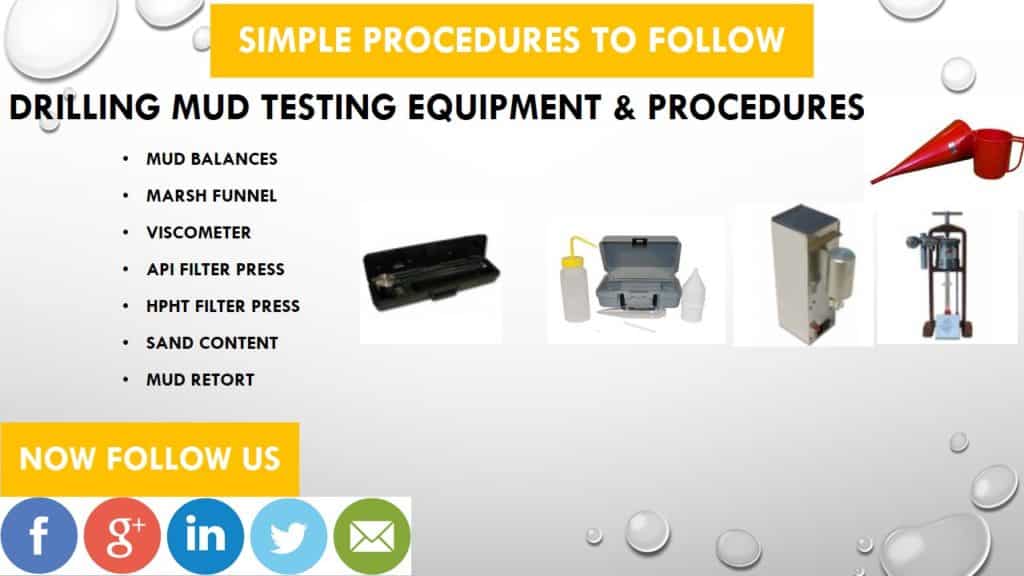The following drilling mud testing equipment & procedures have been standardized by internationally accepted ANSI/ API RP 13B-1 Fourth Edition, March 2009 (Recommended Practice for Field Testing Water-Based Drilling Fluids), which is identical to ISO 10414-1: 2008 (Field Testing of Drilling Fluids Part 1 for Water-Based Mud). But first, before going in-depth on our subject, let’s look at Safety Precautions While Mud Testing.

Drilling Mud Testing Equipment & Procedures For Physical Properties
API and Pressurized Mud Balances for Density
There are two drilling mud testing equipment & procedures for measuring mud density: the API Mud Balance and the Pressurized Mud Balance. The API Mud Balance is suitable for simpler mud systems in top-hole intervals. At the same time, the Pressurized Mud Balance is preferred for deeper intervals because it gives more accurate results by reducing errors due to aeration and compressibility.
Water Based Mud Testing Procedures For Mud Density article handles the right procedures for Mud balance, pressurized mud balance & tru-wat cup,
Marsh Funnel for Viscosity
The Marsh Funnel is a simple drilling mud testing equipment for measuring funnel viscosity, and its procedures are easy. The Marsh Funnel holds around 1.5 liters of fluid and is filled by pouring mud through the wire-mesh screen to remove solids that might block the narrow discharge tube at the base of the funnel. The time taken for 1 quart (946 ml) of mud to flow out of the discharge tube, measured using a mud cup, is then recorded as a time in seconds, with thicker mud taking longer than thinner mud.
Water-Based Mud Testing Procedures For March Funnel The Viscosity article handles the right procedures for using the March funnel with related papers to calculate apparent viscosity from the March funnel viscosity. You will also find a video showing how to use the <arch funnel.
Viscometer for Rheology
A viscometer or rheometer is used for obtaining fluid rheology (apparent viscosity, plastic viscosity, yield point, and gel strengths) (check also Yield Point In Drilling Mud Formula), which is a measure of the resistance of a fluid to flow. Several models are available, powered by a hand-crank or electric motor. The instrument comprises a solid pivoted cylindrical bob restrained by a torsion spring and connected to a torsion dial. The cylindrical bob sits inside a cylindrical outer sleeve that can be rotated at selected speeds, with a narrow annular clearance between the bob and the sleeve.
Water-Based Mud Rehometer | Viscometer Testing Procedures article handles the right procedures for using a Rheometer or Viscometer. You will also find a video that shows how to use the rheometer.
Drilling Mud Testing Equipment & Procedures For API Filter Press (WBM only)
The low-temperature API filter press test, operated at room temperature and low pressure, estimates fluid loss only with Water-Based Mud.
Water-Based Mud API Filter Press Testing Procedures article handles important hints about this drilling mud testing equipment and the test procedures. In addition to that, you shall find detailed procedures and a video explaining these procedures.
HPHT Filter Press Fluid Loss Test Procedure
The HPHT filter press is useful for determining the quality of the oil-water emulsion in Oil Based Drilling Mud. The “free water” in the filtrate indicates that the emulsion is weak. If this is the case, more emulsifiers should be added to the oil-based mud to prevent deterioration in drilling performance.
HPHT Filter Press Testing Procedures article focuses on the procedures and will find potential problems due to excessive filtrate invasion and cake thickness with related videos and scientific papers.
Drilling Mud Testing Equipment & Procedures For Sand Content
It is important to determine the sand content in drilling fluids. If its percentage is high, a thick filter cake will be expected to be formed on the wellbore hole, or the sand may settle down in the bottom of the hole when the mud pumps are off. Also, excessive sand content will result in excessive abrasion of the mud pump and any pipe connections.
Sand Content In Drilling Mud Test Procedure article explains, in brief, the procedures according to API for the test and gives you an idea about the sand content kit. In addition to that, you will find related videos and scientific papers.
Retort Analysis Drilling Fluid for Oil, Water, and Solids Content
Retorts are available with 10 ml, 20 ml, and 50 ml retort chamber capacities, the 50 ml chamber providing greater accuracy. It is important to ensure that the discharge tubes in the retort chamber assembly and condenser are not plugged, as they will then build up in the retort chamber.
Retort Analysis Drilling Fluid Article explains the right API procedures and calculations For oil, water & solid contents.
Drilling Mud Testing Equipment
- Drilling fluid Testing Equipment From FANN
- Drilling Fluid Testing Equipment From OFITE
- Drilling Fluid Testing Equipment From Di-Corp
Lot of knowledge